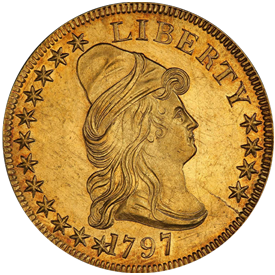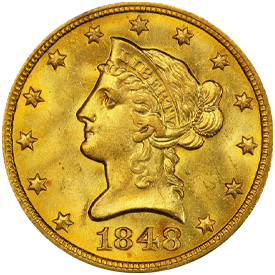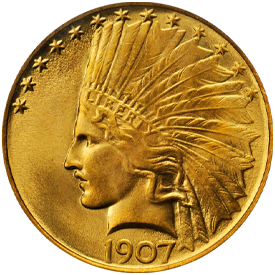The U.S. Eagle served as the base denomination for gold coinage, with most of the other gold issues being expressed either as a fractional, or a multiple of that unit. First struck in 1795, it enjoyed only about a 10-year run before production was suspended for a period of 34 years. Today, that suspension is academic, for even if production had continued throughout the 1820s and early 1830s under the old weight standard, virtually none would remain today due to the mass export and melting that all U.S. gold suffered during that period.
After production resumed in 1838 with a short two-year sub-type that featured a head of Liberty tilted forward, the design remained unchanged thereafter for about 70 years save for the addition of the motto “In God We Trust” above the eagle on the reverse in 1866.
Collectors seeking a complete date and mintmark set of Eagles will have a tough time of it, as the early dates (1795-1798) and 1804 are all mid-five figure coins in circulated grades. Mint State pieces cross well into six-figures. Many branch mint issues in the Liberty series (1838-1907) are unknown in Mint State, and a few dates such as the 1841-O, 1863, 1864-S, all CC mint coins in the 1870s, 1873, 1875, and 1883-O will present a challenge to even the wealthiest collectors. On the upside, most dates after 1885 are fairly common, so a good variety of dates can be assembled with relative ease.
The Indian Head design of Augustus Saint-Gaudens made its debut in 1907 with a limited mintage of wire and rounded rim pieces in higher relief. These, and the 1920-S, 1930-S and 1933 stand out as the keys to this attractive series. A few other dates (typically the “S” mint issues) are costly in high-grade but circulated examples are common. Indian Eagles were struck consistently from 1907 through 1916, after which production became sporadic until the end in 1933. Interestingly two of the most common dates are from this later period; 1926 and 1932.








